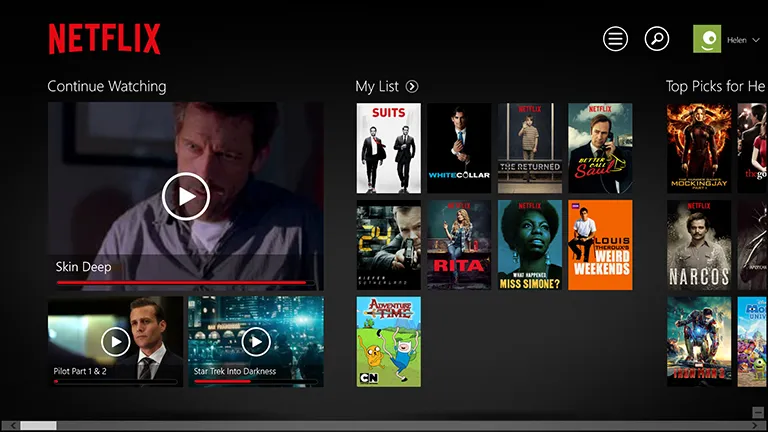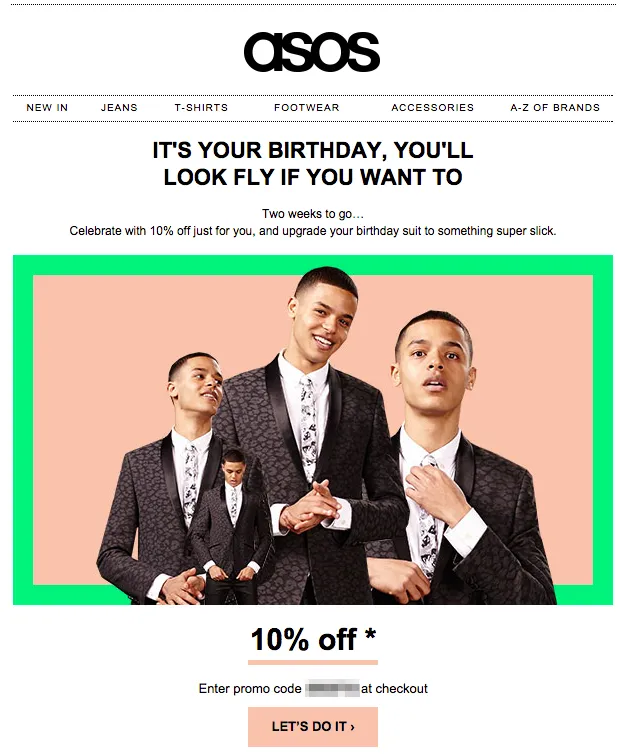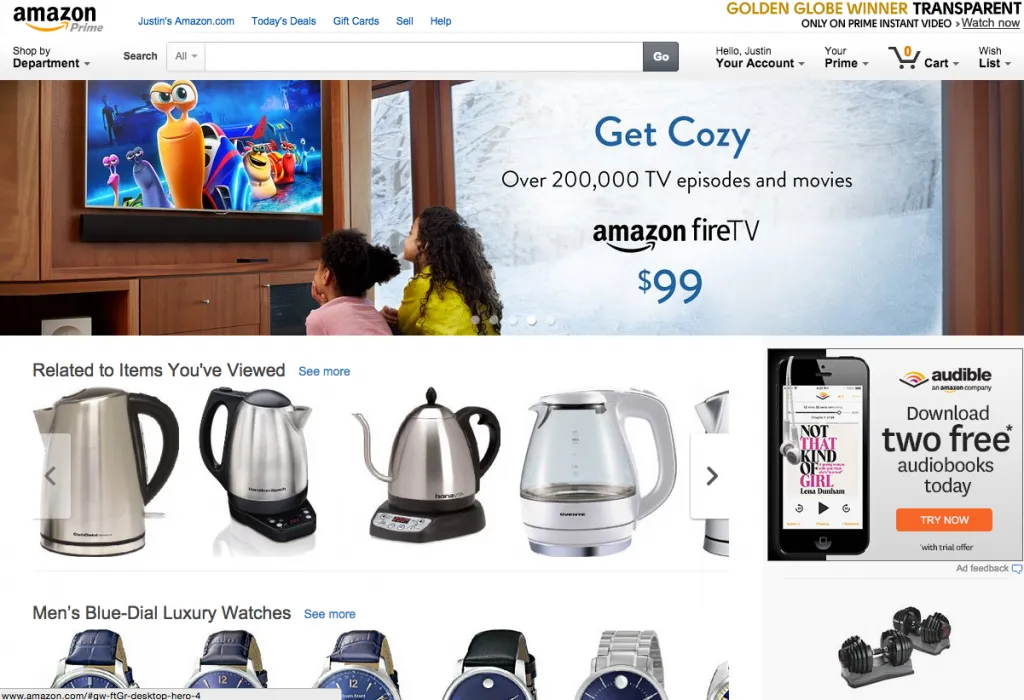What is Lifecycle Marketing?
(Source)
What is Lifecycle Marketing?
What separates the amateur and the professional salesman? It’s not the car, the clothes, or the coffee. Nor is it the product. A real pro could offset global warming by selling ice in Alaska. The approach is what separates the pro and the amateur.
The professional knows that once they've got the prospect’s attention and they're talking value, they've got all day to make a sale. The professional understands that they're going to develop a relationship with their customer and listen to their needs.
The amateur thinks the one who talks fastest wins, that the deal has to be made now or never. That’s simply not true, and this short-term mentality often sends them home empty handed. Truth is, when you know you’re out to create a lasting relationship with a customer, you talk to them differently.
Just like you know you’d rather spend time chatting with a sales professional than the tiresome amateur, customers appreciate this relationship-oriented approach from brands.
This is why customer lifecycle marketing is so effective. Brands build relationships with users throughout their customer lifecycle and across multi-channel touchpoints. Your marketing campaigns are the confident way to show prospects and customers that you’re serious about their needs and capable of delivering on your promises.
This helps lower churn rates, boosts conversions, and improve marketing ROI. Users feel appreciated by the nurturing care and respond by making repeat purchases and referrals. On average, a loyal customer is worth as much as 10x of their first purchase.
What is lifecycle marketing, exactly? Today we’ll define and dive deep on this topic. What the benefits are, how to structure a campaign, as well as examples from leading brands - all this is coming your way. This article is going to show you how to skip the short hustle and go for the big wins with lifecycle marketing.
What is Customer Lifecycle Marketing?
“It’s important to recognize that Lifecycle Marketing isn’t just about sending messages customers might like — it’s about positively influencing their behavior.”
–Anthony Nygren, EMI Strategic Marketing
In essence, customer lifecycle marketing (CLM) engages each prospect, lead, and customer differently because they’re at different stages of the customer experience. Because each stage is unique, this strategy emphasizes addressing customer needs and requirements as they engage with your brand.
Focusing on the entire customer experience, from acquisition to sale to loyalty to referrals means touchpoints are consistent and aligned with your customer.
Different stages of the journey will require different marketing messages and strategies. When, how, and why messaging is delivered is based on contextual messaging. How do we develop a functional approach to crafting lifecycle campaigns?
#1 Customer data: Numerous data sources must be combined to provide a comprehensive, and evolving, view of individual customers while highlighting their preferences and stage in the customer journey.
What does the professional do? Seek first to understand.
#2 Relevancy: Customer insights determine which marketing messages will be delivered to customers at pivotal stages in the customer journey.
What does the professional do? Offer the right product.
#3 Timeliness: The right messages are delivered to the right person at the right time in order to guide them forward to the next stage.
What does the professional do? Make a sale at the right moment.
55 CMOs, VPs, Directors & Marketing Managers discuss the key pillars of a Successful Lifecycle Marketing Campaign in 2017
Now that we have definition, let's ask the experts what goes into a successful lifecycle marketing strategy:

Josh Berg
While there's a million and one things you can do to make the most of your lifecycle marketing, there are three key elements I like to refer to:
Timeliness, personalisation and usefulness.
But, what do I mean about this? Let's ask ourselves three questions for everything we do.
Timeliness - Are we communicating with our customers in a timely manner? Is this the right time to make another touch point?
Personalisation - Are we speaking to our customer like a person? Always remember, they're people - not numbers.
Usefulness - Are we providing value with our repeated touch points?
Only if we can answer the above questions with 'yes' should re proceed with our lifecycle marketing campaign.

Dustin Tysick
1) Consistency - Branding and tone need to remain consistent throughout. You're essentially building a relationship so being consistent and true to your brand is essential.
2) Systems & Data - Lifecycle marketing campaigns are living campaigns, so it is really important to have the systems in place to get clean data and see what is and isn't working. Tools like HubSpot are a huge help with this as you can easily gain an understanding of where people are in their buyer journey and how much of your content they have consumed.
3) Alignment between sales, marketing & customer success - All 3 teams really have to work together as the ownership of the account changes hands throughout their journey. This all ties back to consistency.

William Egan
The easiest way to get all three of these things right is to implement what’s called event streaming. This technology allows you to describe every action a user takes on your website as an ‘event' and send it into your email marketing or CRM.
An entirely new ‘stack’ of marketing tools have been built on the back of the event stream. These include Vero for email marketing, Segment for tracking and Mode for visualisation of the stream.
SaaS Example (Airbnb)
Imagine we have a group of users who typically book new accommodation every two months. Each time they book accommodation we store this behaviour in the event stream as ‘booked accommodation’. We can build multiple lifecycle campaigns off the back of this event, including the standard confirmation email, or a ‘get ready for your trip campaign’.
We can also build more advanced campaigns that listen to the event stream over the proceeding 60 days to see whether the event fires again. Allowing us to automatically send an email if it doesn’t, without the need for engineering. The contents of this email could be simple such as “we miss you”, or more complex such as suggesting “new destinations similar to your last trip”.
2) Send campaigns, not emails
Put simply, send campaigns not emails. At Ausmed, the first email in our abandoned cart campaigns convert at roughly 9%.
That’s great right?
Sure, but what’s even more amazing is how much the conversion rate increases if we send the same email again just one day later. The conversion rate rises to 13% off the back of that second email.
I’m sure you can guess what happens if we send a third time. Yep, the overall conversion rate rises even further, in our case it rises up to 18%—double what we would get with just one email.
3) Referral Lifecycle Campaigns
Customers who refer new users to your product are certainly worth building a lifecycle campaign around. The goal here is to try and identify those moments a user becomes inspired to share.
Once you’ve done this, simply fire an event on that step into the event stream.For example we might fire the event “user create new photo album” when user uploads family photos to dropbox. By monitoring the event stream for when this happens and identifying whether the user also triggers the even “shares album”, we can simply send a push notification or email with the prompt to share.
Lifecycle marketing is much simpler if you just focus on trying to send the right person the right message at the right time.

Leeyen Rogers
Messaging should be personalized depending on your customer's behaviors or profile. On a basic level, if a customer is actively using a feature, they can be excluded from any on-boarding messaging specific to that feature. Instead, use trigger-based and personalized messaging for their specific needs.
Customers do not choose to go with a service solely on the basis of features. Truth is, many markets are saturated at this point and there are usually many solid options for a service, all of which would work just fine.
The more customers you have, the more insights you can gain from them. Data can show you more actionable trends and you'll be able to make decisions that make more sense for your users. Your marketing campaigns should evolve as it grows.

Gil Allouche
Identify account/prospect stage and only focus on getting to the next goal -- when marketing to a prospect, it's important to identify their stage (e.g. Hubspot lifecycle stage) and have a particular message to convert him to the next stage
Example: Anonymous visitor? Convert as a lead using a webinar invite, whitepaper download etc.
Example: Known lead visitor? Convert them to a free trial, request a demo etc.
Build nurture paths -- when you have a lead comes through, you want to make sure to have a clear path to conversion. Usually based on their stage and lead score -- you can decide on a 2 months email cadence that tries to get them to engage many more times with the brand until they're ready for an SDR to call them
Closed loop -- most important is to make sure not to work in silos -- you want you sales counterpart to give you feedback on each and every lead you're passing on to them, take that feedback into heart.
For every "AMAZING LEAD" feedback you want to put more budget+time into that experiment. For every "LEAD SUCKS" you want to understand the attribute and re-calibrate your experiment to exclude that targeting from that particular marketing campaign.

Alex Jumasev
1) Communicate their usage - communicate with customers about the value your product generates. We call this "you're awesome" emails in Jitbit - the messages that includes key usage statistics, and are sent out monthly/weekly.
In our case (we're selling a help desk software app) we include "you handled X support tickets this month, your average response was Y, the resolution time is Z, great job!". Another great hack is to offer a "share on twitter" link, so that the customers can shout this out to the world.
2) Upselling - the key to "negative churn" is to grow your revenue from a customer as the customer's business grows. You know, you landed this customer when they were a small 4-5 person software shop, but now they've raised funds and grown to a big company with offices across the country? Why not offer them to upgrade, or add more features they might not know about.
3) Keep them informed about the product updates - people might not notice the new features being added or bugs being fixed, the app might look "stall" to them.
Make sure you have a simple widget or something, that shows key updates every couple of weeks.
Just a simple list like this:
[new feature] - added tagging feature.
[fix] - resolved bug xxx.
[fix] - resolved bug xyz.

Ben Luks
1. Remember the importance of your company’s reputation. Constant contact with you customers is important, but don’t forget how important it is to maintain and improve the value of the brand that is communicating with this customer base.
2. Understand the customers’ needs. This is fundamental to any marketing campaign, but even more so as you guide a prospect on the path to purchase. Every communication should appeal to the challenges and aspirations that they have.
3. Digital is great, but remember the value of human interaction. This is particularly important for B2B marketing. A company representative communicating with a representative from a prospective company is key to establishing that understanding of customer needs.

Pallavi Sharma
1-Market with Intention --Know who you are marketing to, why you are marketing to them, and what you ultimately want out of the relationship.
2-Listen to the Customer --It's always a conversation and you should be listening more than you are "talking." If you're just blindly sending out messaging without understanding how to meet specific customer needs, then don't be surprised if you only get silence in return.
3-Understand the Customer Journey --Make the effort to know how your customer makes a buying decision. Is there a lot of research up front required to use your offering? Is it an impulse buy? Understanding the journey will help you allocate your limited resources as effectively as possible.
Geraldine Osman
Personalised, integrated marketing across multiple touch points is key to providing the backbone of a strong, ongoing lifecycle marketing campaign.
Re-spinning content into different content forms extends its life and creates the opportunity to plug in more touch points into the lifecycle. An e-book can turn into a series of blog posts, a case study can be turned into a Q and A, knowledge base content can be used as “how to” guides or top tips.Create your content to be multi-purpose from the start and you will get much more value out of it.
Lifecycle doesn’t stop when your MQL converts. Its important to continue marketing to your prospects and customers when they are in the pipeline stages and once they have converted into a customer.Provide value to customers through continual and proactive communications around best practice for your product, early insight into the latest innovations, and offering all of your high-value, thought leadership content that you use to acquire new contacts.

Brandon Gains
1. Mapping out your view of the customer journey - Building out a visualization of every customer touchpoint gives your team a holistic view of your customer lifecycle and uncovers the insight you’ll need to determine which campaigns are needed to improve your marketing strategy.
2. Evaluating your marketing technology stack - seeing how your current mar-tech investment fits into the customer journey highlights critical gaps in your customer experience and helps your team evaluate the true benefits of different marketing technology vendors.
3. Building out a post-purchase engagement loop - many marketing teams are solely focused on driving brand awareness, buyer consideration and the initial purchase that we don’t give the same attention to our retention and loyalty programs that can produce similar revenue gains.

Mana Lonescu
1: Don't skip steps! Your contacts won't go from a lead to a loyal customer over night! In many instances, loyalty takes years to build. And there are stages to it. First, you need to get them to hear about you, then like you, then want you, then try you out, then come back. And come back again. And other nuances only you may be aware of by knowing your customers. You'll need marketing for all those stages. Skip a step and you may lose them.
2: Collect, categorize, communicate. You'll want to collect as much behavioral data as possible. This is often complex and starts with the technical step of setting up a solid database and structuring the data (categorize) in a way that will power rather than hinder your marketing. Then communicate, communicate, communicate.
3: Don't get stuck on one channel. Your customers live their lives on multiple channels, for different reasons. They go to Facebook for entertainment, to Pinterest to research, to email to learn, and so on. Your lifecycle marketing should not just take into account where your customer is at in their relationship with you, it should also take into account how they spend their time online.

Jake Godgart
Understanding where your audience is in the lifecycle (segmentation) and aligning information to their stage - I classify lifecycle marketing into 5 broad stages - Awareness (getting noticed), Education (providing useful information and validating need), Impression (why the product is the obvious choice), Delivery (providing additional value post sale), Ongoing (customer views you as a business partner for success - both in education or additional incentives that do things like encourage referrals).
The purpose of lifecycle marketing is to create or maintain & improve upon the relationship your company has with the external world, yielding improved company revenue - whether that be retention or generation.
For example, early stage prospects need to be treated differently than someone who is deeper in the cycle. Using a newsletter to guide the prospect towards your product over a series of light touches is more effective for someone who falls into an early lifecycle stage than pushing them towards a demo form request with little familiarity with your product.
Lifecycle strategy must encompass everyone, from prospects to your existing customers - A successful deck of lifecycle campaigns focuses on contacts in every stage. Lifecycle marketing is not just for prospects; lifecycle extends from an unaware buyer, through an active lead in the sales process, to onboarding, and post implementation for existing customers.
Many times we get caught up in driving and nurturing leads, but we should never forget the value of an existing customer and the impact that lifecycle campaigns can have on increased product usage and reduced churn.
Create a harmonious balance of automation & personalization - Automation relieves your sales, marketing, and customer success teams from connecting with prospects and customers at a 1:1 level when they may not be at the stage in their buyer journey to warrant a reach-out.
However, understanding when to reach out, timing between each touch-point, the order of communications, lag time, and most importantly when to stop can still provide a personal feel, while syncing harmoniously with your automated flows. And make sure there’s tracking in place to measure success, testing, and ensure accountability for the non-automated functions.

Blaine Bertsch
Know your customer inside out and segment them so that you are highly focused on your initial touch points. Personalization is key and communicating the right message at the right time in the buying cycle.
Address their unique pinch points, again with as much personalization as possible. Predict what will address their friction, based at the point they are at in the process.
Don't stop at a sale, retention is critical for your bottom line and much less costly than acquiring a new customer.
Bradford Swanson
Lifecycle marketing campaigns have to treat prospective customers with a great deal of respect, and acknowledge they're smart, informed consumers.
The 3 key pillars I rely on are:
1) Minimize touch points and copy length so that you're not hitting your prospective customers over the head. Subtly and concision are really important.
2) Answer the questions prospective customers have. You've seen these questions come in through support, social and other channels. Use them as catalysts for content, map them to the customer journey, and bring them into your nurture stream in a way that can really help your leads get excited to join your fold.
3) If you're going to go personal, like an email "from the CEO", it has to be genuine. I'd rather get an email from a customer support representative who's able to respond promptly to my questions, and then I feel like I have my own personal point of contact within the company.

Michael Morgenstern
1. Content - Having an arsenal of excellent content will allow you to provide your target market with valuable and relevant blog posts, case studies, infographics, whitepapers, videos, etc. at every stage of the funnel. We segment our content into 3 categories that focus on top, middle and bottom of funnel prospects.
Your top of funnel content should include helpful evergreen information on your industry at a macro level, such as state of the industry reports or a company overview explaining the features and benefits of your product / service.
Middle of funnel content should focus on case studies, "how-to" guides / videos, providing relevant examples of how your prospect can solve xyz problems by using your product / service.
Bottom of funnel content should go directly for the hard sell. Provide your prospects with trial access or discounts to your product / service.
2. Marketing Automation - Leveraging a marketing automation platform can help you gain efficiencies and allow you to create intelligent drip campaigns - a stark contrast to traditional email marketing which requires lots of manual segmentation and analysis for each and every deployment.
We currently use Autopilot HQ, which integrates nicely with our Salesforce CRM. We can easily setup journeys for our prospects based on metrics tracked within our CRM. Once a prospect meets certain criteria, such as lead score, or # of purchases, they'll flow into a relevant email journey, moving them further along the funnel or tapping them for repeat business.
3. Analytics Tracking - It's crucial that you are correctly tracking your prospects' interaction with your email campaigns, behavior on your website, purchase history / revenue generated, and all other touch points across your various marketing channels. Proper tracking will allow you to adequately segment your prospects and provide them with the highest level of marketing.
We track our prospects behavior with our email marketing platforms (Autopilot HQ, Mailchimp, Campaign Monitor, etc.), on-site behavior with Google Analytics, and revenue tracking via Salesforce, in addition to a number of other tools which give us a holistic view our prospects.

Gavin Conway
Before the budget has been allocated, the product and website built it is imperative that you are super clear about the audience you will be selling to and the pain points you will be solving.
Never forget that your current and potential customers are real people. It makes me shiver when I hear the phrase ‘target customer’. Last time I checked no-one ever described themselves as a ‘target’. When you see people like this, your communications and campaigns tend to become very restrictive to very functional messaging and channels which inevitably lead to low engagement and are counterproductive.
In a startup its easy to get into a build and release cycle in response to market feedback. It sounds slightly counter intuitive but the best way to add more customers, is to focus your attention on delivering what your existing customers want.

Mostafa El-Bermawy
1) Understand Your Persona, know The People: You have to know your buyer and what they’re thinking before you can even develop something for them. You have to spend time in the tools, websites and places that they frequent before you can even start to reach them. In person meetings with customers and sales team feedback are often help refine that understanding.
2) Right Place at the Right Time: Map out your outreach and marketing strategy to make sure your content lands when it’ll make the best impact. It won’t do any good for content supporting decision or retention to fall in the laps of the people that are just becoming aware of your brand. It has to be there at the right place and right time to make an impact.
3) Shift Channels…or Don’t: Obviously, email marketing is huge within lifecycle marketing. But sometimes that’s not going to put you over the top. Maybe it’s retargeting. Maybe it’s a Facebook or LinkedIn Ad. Or it could even be going to the key conference of the year to close a few deals. Or if that bottom funnel email is doing the hard work for you, stick with it.
If the research was done and in the content is in the right place, that final channel may look really different depending on your audience. Scale up successful campaigns and scale down unsuccessful ones. Continue testing and iterating and stay with it.

Ben Bradley

Joseph Santos
1. Partner with your Customer – gain insight into every step of the customer journey, with a deep understanding of your customers' challenges and experiences, you can create targeted programs, increase loyalty—and drive revenue.
2. Multi-Channel Marketing – you can have direct sales in a co-sell environment, leveraging one or more partners to provide the “whole product” from core solutions, to add-ons, to services, geos and vertical markets. Customers need the complete solution and partnering can extend their reach—and yours.
3. Your Sales Team is your 1st Customer – establish a clear line of communication with the sales team who will sell the solution. Get advanced buy-in from sales leadership, train sales teams, provide sales tools and establish a cadence even before you launch your marketing program. If you can clearly establish why your sales team will benefit, so will your organization— and your customer.

Ben Fineburg
First, the consumer today is so much more savvy than ever before. They’re smart. They have options, and they don’t want a run-around or a bait-and-switch. So one simple key to creating a loyal customer is transparency.
There aren’t any panaceas that create a utopian world out there. We know it by now. Tell us what you offer and how it helps in a real, transparent way and people will take notice.
The second key to lifecycle marketing is to talk about the benefits. See point #1, and don’t try to pull the wool over everyone’s eyes. But sell the benefits from an emotional standpoint. I believe that people make decisions based upon emotions.
Use the benefits as an opportunity to create a connection with your audience. Tell your story. Draw them in and make them FEEL what you’re saying and not just hear it.
Finally, I would add the company needs to be seen as one that’s worth doing business with or buying from. See United Airlines and Pepsi for recent examples to the contrary. Do your very best to reach the customers through the different channels where they live, but don’t have some monster behind the door when you do eventually connect.
We like to market and advertise for companies whose products actually make a difference in the lives of the people who consume them.
If you want to create a customer for life, be a worthwhile organization, be transparent and connect emotionally with your audience about the benefits of doing business with your company or buying your product.

Duke Merhavy
1. The Sales Funnel Isn’t
Everything that enters the mouth of a (true) funnel comes out off the bottom… This is not the how it works in sales. Some leads choose a different route, and we – as marketers – should
know where they are and where they go. Leads that don’t follow the path we envisioned for them (start here and finish there) are not lost and are not to be dismissed or abandoned.
2. Referral Programs Should Be Part of The Cycle
Getting referrals should not be occasional or just a pleasant surprise. Getting referrals should be part of a deliberate, planned, and calculated marketing effort directed at our customers. In addition to the obvious revenue-enhancing benefits from new customers, referral programs remind current customers of their positive experience with the brand and encourage them to make more purchases.
3. Avoid ‘Spinach Marketing’
The ‘Spinach Marketing’ concept boils down to “here it’s good for you – eat it!”. As marketers, we do our best to come up with the most effective campaigns we can. And once we do, we tend to launch and focus on implementation only. We should, at least with regular intervals, review the behavior and preferences of the targeted audience. If our campaign does not match their lifecycle as customers, they will ‘vote’ with their wallets and other behavioral indicators – pay attention, and adjust as needed.

Colin Bovet
1. Use marketing automation to check in on new customers and see how they're doing. We've found these emails get very high engagement rates and provide valuable feedback on our product and process.
2. Use multiple channels to reach prospects and customers instead of relying on one method like email. We use a combination of email, social media, in-app messaging, our blog, and even phone calls.
3. Develop a clear, compelling referral program and strategically promote it across multiple channels. It should be built into your product dashboard, announced on your blog, and brought up in sales calls. We did a well-received email and social campaign for Valentine's Day to encourage our customers to "Spread the Enp-Love" by sending their friends our way.

Bryan Holladay
Define Your Why
In the sports nutrition category, you have to really understand your customer base.
They can often see right through your marketing messages and can smell when you’re trying to sell something. Thus, having a clear goal of what story you’re going to tell the customer through your lifecycle, the easier it is to sell them on the idea of your brand.
At Gnarly Nutrition, we focus more on the development of people, i.e. helping them become better by helping them discover the gnarliness inside of them. This simple idea of helping people discover their inner fire allows us to create a messaging strategy that’s familiar to how these athlete’s worldview. Thus, they are more likely to engage with our messages when our messages reflect their ideals.
This enables the customer to move past the fact that we sell nutrition products and buy into our culture and general brand image. The brand goes from being a lone coat they see amongst other similar coats, to a coat they want to try on.
This is how we influence our customers to stick around.
Personalization
In a digital world, sometimes it is nice to get something not digital.
Recently our CEO decided to handwrite letters to our customers thanking them for being faithful supporters of our brand. These personal letters are probably not the most efficient use of a CEO’s time, but they have been a very effective technique in helping to build brand loyalty.
Therefore, in a world that’s increasingly impersonal, it’s not a bad idea to create personalization in your customer’s lifecycle. This lets you show your customers that you care who they are, and that you are conscious of how your products are benefiting them.
So, get creative. And think of ways to personalize your user experience.
Customers Need Three Reasons
They will stay if they have reasons to stay
Brand advocacy is built when customers can argue at least three reasons why your brand is better than an alternative brand. Those reasons are usually
1) Great customer service,
2) A strong product that helps them meet their needs, or
3) Their trusted friend/colleague referred them to the brand, and so on.
For Gnarly customers, it’s all about
1) Our clean, great-tasting product
2) The brand’s ideals, and
3) The athletes that rep our brand
Our customers honestly love our products, especially the taste of our products. And they love that our products are clean and free of any harmful substances. This is huge. It’s awkward to expect people to like your brand when you don’t have a good product. After all, that’s what they came for.
The great part about number two is that it’s more than expected. Essentially, customers come for our awesome products, and stay because of our relevant message. Therefore, customers are getting more than they bargained for, they’re getting a “plus one.” They’re getting the right products and a family of individuals that believe the same things they do. This motivates them to stay because they are surrounded by athletes (via social media, etc.) that motivate them to achieve their highest potential.
Lastly, our athletes are awesome. Therefore, our customers are awesome. You attract what you put out. If your brand produces mediocre athletes, you will attract mediocre athletes. But if your brand produces the best, you will attract the best. It’s an image thing. But it’s also a personal thing.
Customers accept brands on the same terms as they accept new friends. So, make your brand look good. Be friendly (not intimidating). And give your customers an experience that’s noticeably professional, but also overwhelmingly personal.
When you build a brand that gives your customers three (or more) unique reasons to stay, you will find that your rate of repeat customers will increase.

Lucy Snell
It’s no secret that it’s far easier to gain business from existing customers than it is to attract new customers. Businesses need to have a system in place to build a relationship with their customers, right from the start when they are prospects and continuing as they move through the lifecycle.
The 3 key elements of a successful lifecycle marketing campaign are:
1. Identify the different stages your customers go through all the way from acquisition through to conversion and retention and then winning back lapsed clients.
2. Using personalisation is key to effective lifecycle marketing. The more you can recognise that your customers are individuals and can use messages to make them feel special and unique, the more successful your campaign will be.
3. Make sure you are planning your marketing campaign in an integrated way and don’t just focus on one channel. Look at the customers’ entire journey across all devices and channels and make sure all aspects of your marketing collaborate and pull in the same direction.
Lifecycle marketing is a great way to build relationships with your customers and convert more sales but as with any strategy it requires testing and iteration. Constant monitoring of campaign results is crucial to check whether the campaign is working.
An effective lifecycle campaign should:
Provide real value. Customers seek us out because they have real problems they are trying to solve. Rather than pushing for a quick sale, use the opportunity to educate customers and guide them towards a point that aligns their goals with those of your business.
Tailor messaging based on customer behaviour. Actively engaged customers have different needs to those who haven’t been back since signing up, and effective campaigns make sure to take these kinds of differences into account.
Be part of an experiment and data-focused culture. Don't "set and forget" lifecycle campaigns – A/B test the copy, run tests on headlines and touch-points, and make sure you are continually improving both sales and customer satisfaction related KPIs.

Rob Tutty
Lifecycle marketing is about thinking of your funnel as a complete cycle, and not just a funnel with a top and a bottom. Picture your perfect customer - they don’t just work their way through your funnel once, and disappear after a single purchase - they keep coming back.
Treat your marketing team as a whole, and not silos of Brand, Direct Response, CRM, Website etc. Linking up these areas enables you to reach every part of your lifecycle across multiple platforms, with consistent and relevant messages.
2. Deliver Value
Deliver real value throughout the whole customer lifecycle, whether that is top of the funnel content, or bottom of the funnel promo codes. While your goal might be sales or registrations, you shouldn’t expect something for nothing. Therefore it’s important to build a relationship with your customers. So share insights, ebooks, product sneak previews, blog posts, newsletters - anything that adds value for your customers.It can take as many as 7 touches with a customer before you are able to convert them to a sale. Therefore a well structured drip-feed content marketing campaign will enable you to push your leads through the lifecycle.
3. Measure Everything
It is imperative that you measure all stages in your lifecycle and understand downstream metrics with upstream touchpoints. If you don’t, you can’t optimise. With visibility of exactly where your leads came from (e.g. email, social), you can optimise your spend to those streams that convert the best.
Use tracking links like bit.ly, and add utm tags to your landing page url’s. In addition, if you are using an automatic lead sync platform like Driftrock Lead Response to pipe your social advertising leads to your CRM, tag your lead lists with unique identifiers. Additionally, ensure that your email marketing provider gives you the ability to track open and click rates.

Amy Groden-Morrison
Care: Show your customers you care by asking them for feedback and using it. Make sure to close out polls or user conferences by addressing the feedback you heard and what you're going to do to address customers' concerns. Nothing builds loyalty better than a vendor who pays attention to customer concerns. And many great ideas -- for new programs to differentiate or set vision for your product -- come from your customers.
Context: Make sure to segment your customer database and send them material, offers and information in context.
Make what you send is relevant to: 1) the type or size of organization and/or industry 2) their software package/license agreement and 3) lifecycle stage. Nothing frustrates or confuses a customer more than receiving offers or information that has nothing to do with them.
Choice: There are many different channels and formats of communication -- know your customers' channel(s) and format(s) of choice and respect it. Do they prefer email or a social media channel? Is text an option or preference? Do they prefer their emails with or without text? Would they prefer a phonecall?
Knowing how and where your customer wants to hear from you immediately establishes credibility for your sales reps -- and makes sure your message will reach your customers -- in a busy world of information flow.
Greg Johnston
Successful lifecycle marketing are marketing programs that are focused on your customer’s needs and usage.
Here’s 3 key areas to create successful Lifecycle Marketing programs with your customers.
1. Value Communication
Communicate with your customers on a regularly about the value you are generating on their behalf.
Doing this form of communication shows a dedication to delivering ongoing product improvements and value to your customer.
Value-based marketing campaigns include new features, fixes, new content and events you are organizing or attending.
2. Product-based Upselling
Offer additional products that speak to your customer’s need and usage.
Understand your customers including what they purchase and how long.
Focused campaigns around product purchases including; buying one or more products, special bundle offers or special pricing offers based around the prolonged period of use.
3. Usage-based Programs
Know exactly how your customers are using the product and the usage cycle.
You can send them communications around content, events, features and special offers.
Monitoring this allows you to trigger e-mail marketing campaigns around your Lifecycle Marketing.
Chris Carter
Great Content - Providing value is one of the most important elements of any Lifecycle Marketing Campaign. We're all bombarded with sales emails, ads and misleading offers. The most effective campaigns that I've ever seen is where the company or person provides real value within the first 3-5 touchpoints of a campaign.
Free content that works will gain the trust of your prospect and when the offer does finally come in the form of a launch or promotional period, the conversion rates are substantially higher.
Fractionalized Content - Here's a recent article I published in Adweek: https://www.adweek.com/digital/chris-carter-rep-interactive-guest-post-fractionalized-content/
The key here is that even with a Lifecycle Marketing Campaign, creating content specifically for individual audiences/platforms is far more important than creating a one sized fits all approach.
Consistency - I've seen lifecycle marketing campaigns die because the author gives us just before the finish line. Either they get too busy, get discouraged, or run out of content due to a lack of planning. Either way, long term consistency trumps flash in the pan marketing efforts.

Ryan Hill
- It is absolutely imperative that the Sales team sets a clear expectation for the client and relays the information to be correctly fulfilled. Too many times have I had clients that were promised something that could not be delivered and the relationship was soured. This can be detrimental to the entire agency as the reputation is then on the line.
- Communication is key. Even if the performance of the account is not up to expectations. Letting the client know that you're "on it" will keep their trust in your abilities.
- Send them "wins" and be truly interested in their business and personal lives and pick things out from previous conversations that you can touch on later. Things like a sick family member or their kid winning a baseball game. Sending a little gift for a special date shows how you really care.
- Make damn sure your team fulfills (within reason) what the client has expected.
- Go above what was promised. (Underpromise and over-deliver). This gains the clients trust and sets up your team for referrals and up-sells.
- Align your client with the right team member. If you don't know your team, there's a big problem. Personalities can clash or they can flourish. Having the right team member assigned to a client can make or break the relationship.These are just a few things that are crucial to a successful campaign but they've proven to be the most important. Even above knowledge of advertising and creativity!

Tanner Hakert
First of all, I believe that creating brand awareness and recognition is an important early step of a successful lifecycle marketing campaign because sometimes timing is off. If you are advertising to a customer during a time when they have no need for your product or service, it is very unlikely that they will buy it.
But, if you can give consumers a reason to remember your brand specifically, whether it’s a logo, a motto, or a catchy jingle, when the time comes that the consumer is in need of your products or services, they will be significantly more likely to remember and do business with your company over your competitor’s.
Another element that is essential to a successful lifecycle marketing campaign is frequent and personalized communication with your customers. Sending our personalized emails, texts, letters, or any other form of communication is a great way to show those customers that, to you, they’re not just another customer.
By tailoring the content of the communication to fit one person specifically, you can align the content of the message with the needs of the customer. This will not only result in more sales, but also in more loyal and returning customers.
The last, and quite possibly the most important, element of a successful lifecycle marketing campaign is having a very detailed and in-depth knowledge of your target audience. These people are your bloodline. Without them, the products or services that your company sells would mean nothing. Because of this, it is extremely important to make sure that you know what they like and don’t like, what they respond to and what they ignore, and how familiar they are with your service throughout every step of the purchasing process.
Improving your knowledge about your target audience by reviewing feedback and analytics will give you a much better understanding of when and how to market to them, which will lead to more sales, more happy customers, and more money in your wallet.

Erin Simmons
It isn't just about a lifecycle campaign, it's about lifecycle marketing! Every marketing channel and tactic you tap should be structured across the marketing funnel -- awareness, consideration, conversion, adoption, and advocacy. Here's my 3 must dos when it comes to lifecycle marketing:
MEASURE IT -- Make sure all your tactics are measurable to ensure you're spending your time where it's most valuable.
ATTRIBUTION -- Don't forget about attribution tactics! You should have display campaigns that are set up specifically for your awareness and consideration targets. These will have low conversion rates. What's more important is what their attribution rates are -- are these tactics allowing other channels like direct and organic to be more successful? If it's a good campaign, the answer to that question is always "yes."
CONTENT -- Create content for every stage of the marketing funnel. The most important in my opinion is "up-funnel" content. Identify key indicators early on that would suggest in the future a customer may need your product/service. If you're a moving company, an example of some up-funnel content you could create is a neighborhood guide, a city guide for folks who don't have car, or a guide for how you know when it's time to close a business.

Holly Chessman
The three key elements of a successful lifecycle marketing campaign are self-service channels, responsive channels, and live channels. You need all three in order to comprehensively cover your bases.
On the attraction side, it's important that you provide material for prospects who do their own research. Self-service channels include your website and external publications. Provide clear and helpful content about your products/services on your website, thought leadership pieces on your blog, and informational pieces in various external publications.
This kind of content allows prospects to discover that you have the solution to their problems.
When you get to the selling part of the process, you need to be looking more into responsive channels. This includes email, social media, and other venues that allow you to connect on a more personal level with your audience. Here you can start to answer some basic questions and move prospects towards becoming customers.
Overlapping with the sell and moving into the "wow" phase, live channels become key. Here is where you have the truly high-value proposition. It is with live channels like phone and visual engagement solutions (cobrowse, one-way agent video, etc.) that you will close the deal, provide onboarding and support, and create long-term advocates that will both renew and spread the word about how amazing you are.

Karen Sage
The 3 key elements of a lifecycle marketing campaign:
- Consistency of intent
- Authenticity in engagement
- Recognition of customers as individuals.

Clayton Johnson

Don Montgomery
1. Super smart marketing people
2. Clear, measurable objectives (Use the SMART acronym: Specific, Measurable, Attainable, Realistic, and Time Bound)
3. Precise targeting
Anthony Less

Katy Jones
1. Never lose sight of your customer. Any good marketer begins campaign planning with their customer in mind but as you're in the trenches of execution, you can lose that focus. It's always good to set checkpoints to make sure you are customer-centric through every stage in the customer lifecycle.
2. Be agile. Customer preferences change and your marketing should evolve with those changes.
3. Automation is essential, but so is testing. Marketing automation has completely changed the landscape of marketing, but it also leaves room for major missteps in the lifecycle of a customer if proper testing and QA isn't done right.

Jennifer Schuder
As with any good marketing strategy, lifecycle marketing begins with clearly outlining your goals, the target segments of your audience and how those goals will be measured. Determining the desired outcome is critical to developing the campaign tactics that will drive prospects and customers to that outcome.
Here at the State Fair of Texas we are leveraging this approach to encourage participation in the Fair. While we love the millions of people to attend the Fair from all over the world, we want to entice more participation in the Fair through our Creative Arts and Livestock contests.
So we have developed automated “Welcome Campaigns” and targeted content in all communications that encourage our audience to take the next step and enter their “famous” apple pie or participate with in the poultry contest with one of the chickens from their backyard coop.

Kent Lewis
1. Onboarding: bringing new customers into the fold (once they’ve committed).
Key elements include:
a. Thank you page/welcome page (via website or email links) provide an excellent opportunity to validate the purchase and reduce post-purchase dissonance.
b. Welcome email (auto-trigger or manually sent) and ideally combined with thank you/welcome page above to re-emphasize key benefits of being a customer and links to related resources, including tutorials and FAQs.
2. Retention & Growth: the meat & potatoes of any CLM campaign focuses on ensuring clients/customers are happy and engaged:
a. Email or old school handwritten notes celebrating milestones like anniversary date as a customer or better yet, personal milestones like wedding anniversaries or birthdays.
b. Automated reminders around basic customer support, including renewals, alerts and promotions
c. Outreach regarding up-sell/cross-sell opportunities around current product, service or subscription. CRM/marketing automation systems should be tuned to trigger these opportunities, but following up with phone calls and in-person meeting requests is recommended.
3. Evangelism: turning your customers into your sales and marketing team via delight and elevation:
a. Identify happy customers (via NPS surveys or other strategies) and make the ask via email, phone or in-person.
b. Online ratings & reviews: Yelp reviews drive business, so strategically request customers review (without incentive) and provide links to appropriate review or industry sites
c. Testimonials & case studies: same as above, but may require a more personal touch
d. References & referrals: grow business via validation and leveraging your network

Cheryl Russell
Relationships. Know your client. Let them speak.
The single most important element of marketing is to remember the relationship is key. Whether it is a potential client, active client, or former client, relationship building is the focus. We do business with those we like and we like those we know.
Your campaign should be as focused on the customer as possible. Sometimes that means targeting one segment of the lifecycle (former client, for example) but sometimes it means you can place your target even closer to a very specific type of former client.
As an example, you may have several clients who have dropped off due to lack of communication or they previously had purchased all of your services they needed. Each of those subsets of former clients are very different and how you’d connect with them is different. Know your client and make sure you are reaching out effectively.
Whether former client, current client, or prospective client, they all have one thing in common, and likely more. Ensure they have opportunities to be involved and to communicate their experiences and needs of your products. Events you sponsor, social media, professional networks, or requests for feedback that you share within your network, will all creatively create spaces for relationship development.

Matthew Perkins
1. Content Matrix - We create a spreadsheet of each area of the buying funnel, then match it with pain points of each of our client's personas. Whether they have 3 or 4 or a dozen different target personas, we spend time learning why they do what they do. We also ask them why they refer our client to their friends. We then write content at each of these points.
2. Gated Content - We use gated content at each of the areas of the buying funnel. The closer to a decision making point it is, the more qualified they are in our CRM. (I'll get to that point next) We use the blogs that we create and then create correlating gated content for folks to learn more. This even includes those that have already purchased but want to learn how to use the tools better.
3. Lead Scoring - For clients (or ourselves) where the buying cycle is longer, lead scoring is important for us to gauge interest and interactions with opportunities. As someone moves down the buying funnel they have interaction points such as emails with links to more in-depth content, or important pages that they can visit.

Eric Majchrzak
1. Content must align with the buyer’s decision-making process. Your message must be relevant at the top (awareness), mid (interest/desire) and bottom (action) of funnel. The needs and attitudes of the prospect are very different depending on the phase they’re in.
2. Your job as a marketer is to remove any friction or obstacles to the purchase.
3. Offer a path between the pieces of content that walk the buyer through their journey. Serve them up accordingly.

Maneeza Aminy
Developing a solid marketing campaign is hard. In the past measuring its performance was not possible, today there is much data you can unravel a proper story. So the trick is to make sure you are VERY clear at the beginning as to what you are trying to accomplish:
3 key elements of a successful lifecycle marketing campaign?
1. The campaign will give you net new insight(s) into your customers and prospects. Nothing is worse than running a campaign with no data to course correct or learn from. Leveraging tools like Marketing Automation are critical in identifying such insights.
2. The campaign has a clear objective that you will be able to measure against. Your campaign needs to have a point. e.g. We want them to book a meeting with us, We want this campaign to clearly influence renewal, We want this campaign to give our clients an opportunity to ask questions. We want this campaign to identify industry evangelists for us on social media. etc.
3. Marketing, Sales , Renewals, essentially all areas of your org will be aware of this campaign. Activities against follow up, lifecycle management, sales alerts etc, need to be orchestrated at the Account level throughout your org.

Luke Trovato
Conducting a successful lifecycle marketing campaign is a lot like going to the doctor. It may not be the most fun or exciting thing in the world. It may be a little tedious. And it may involve a bit of waiting around for results to come back. But, it is nonetheless essential for the health and growth of your business. A strong lifecycle marketing campaign will likely exhibit some or more of the following symptoms of success:
1. Becoming intimately familiar with your target customer.
It is important to come up with a list of questions to diagnose the behavior of your target customers. Where do they spend their time online? What are their pain points related to the products and services you are selling? What are the most important factors they are looking for in products and services like yours? What are the best ways to reach them, and how often do they like to be contacted?
How do you acquire most of these answers? Simply by talking to your customers. Send out surveys if you'd like. Or just ask some of these questions in passing if you're on the phone taking an order or answering a customer support email, even if it's slightly unrelated. Assuming people are enjoying your products and services, they typically like to talk about their experiences.
This can certainly be a challenging endeavor, especially for a start-up company that has to begin from zero when it comes to customers. In this case, just try to think of people you know personally who most closely resemble what you believe to be your target customer. Ask them these same questions. Yes, this relies on you making some educated assumptions initially, and, what do you know, that perfectly segues into my next point...
2. Monitoring, Evaluating and Adapting.
Breaking News: You will not get everything right on the first try! Sometimes signs and symptoms can be tricky. Sometimes you must make assumptions based on little information. You're not going to bat a thousand when it comes to every aspect of your campaign. The important thing is how you handle it.
For starters, you want to make sure you are monitoring the right metrics. Ask yourself: If you have a fever, what is one of the most important areas to monitor? Your body temperature. Now ask yourself the same question again for your lifecycle marketing campaign. What performance metrics and indicators of success do you need to be monitoring? Acquisitions? Retention? Visitors? Conversion rates?
Make sure you clearly define the goals of your campaign and that you have methods in place to track all the relevant data.
As you begin to compile the relevant data and metrics, don't just let it sit there. Take out that scalpel and really dig into it. What is working well in your campaign and what isn't? Is it performing as you expected? Why or why not? You need to be constantly evaluating your results. The last thing you want to do is spend your time and money on pieces of a campaign that aren't working for you. Always monitor those results.
If the symptoms don't respond to one type of treatment, then it's time to change course. As tough as it may be to cut bait on your great idea, you might have to do just that if it's not providing the results you need. As frustrating as it may be to totally abandon an email marketing campaign you spent hours working in, don't look at it as a wasted effort. You at least gained valuable insights into your customer behavior.
Remember, an important process of a diagnosis is ruling out what is NOT the cause. To do that, you will need to test many different theories. Especially in the beginning, marketing campaigns are often a series of trial and error. As mentioned above, you're going to have to make some assumptions along the way--especially in the case of a startup--and that's okay as long as you are willing to adapt and change course as necessary.
3. Continuously Experimenting
As anyone in the field can tell you, the marketing machine never stops. Once you go through the processes and build a successful campaign, you can't simply expect to sit back and watch the dollars roll in. You obviously want to continue spending time and resources on what works well for you, but don't completely abandon the generation of new ideas. You may miss out on the next treatment that works a little quicker and produces slightly fewer side effects.
Make sure to reserve a little bit of your time and budget for the exploration of new theories, methods, techniques etc.
Be sure to also pay attention to the evolution of technology around you. Your campaign may be running as smoothly as possible right now, but there may be a new piece of software or another tool that could make it more efficient and productive.
The marketing technology field is always expanding, so make sure you stay up to date on the latest resources and trends. There may be newer, better ways to connect with customers, capture data, evaluate strategies or organize your lifecycle campaign. You don't want to miss out.
The world of marketing can sometimes be a scary place to navigate, but if you keep these principles in mind, you'll be well on your way to success. Just take these three elements and call me in the morning.

Jen Spencer
1. First and foremost, a deep understanding of your buyer personas. Buyer Personas are semi-fictional representations of our ideal customer based on real data and some select educated speculation about customer demographics, behavior patterns, motivations, and goals. They’re our people. They’re the reason we exist as an organization. And there’s more to them than a job title, an industry or a region. By better understanding these individuals, we’re able to create better content while also identifying how and where our ideal customers consume that content.
2. Strong virtual listening skills. As marketers we have the ability to track pretty much everything, so pay attention to the signals your prospects are sending you. What events are they registering for? What kinds of emails are they opening? Don't just track what they do — use that data to change the way you communicate with them.
3. Authenticity and creativity. Your prospects are people.They have good days and bad days. They are busy. You are not their #1 priority. 100% authenticity and a little bit of creativity goes a long way in cutting through the waves of automated noise that fill our inboxes each day.
Helpful resources:
Blog Post: The Quick Guide to Co-Marketing with your Channel Partners
Blog Post: Authenticity in Marketing and Its Importance in the Channel

Brad Morrison
2. Align Sales & Marketing.
3. Use gated content to qualify and route leads.

Jana Garanko
Try to put yourself in the place of audience for whom you are doing the campaign. For this you need to know your public and as inbound marketing say - create your buyer persona and than use those right channels that you audience love. If your don't know what flowers your girlfriend love - there is less chance to make her happy. That's the same.
The second thing is to think about all funnels you will use and plan your actions for all the campaign. For example, one of our latest campaigns Easter Egg Hunt Game was planned for all possible channels. We defined the main goal for this campaign as to have fun by uncovering 15 easter eggs to get an exclusive SEMrush data.
We thought about QAs, SMM promo, email marketing and some more. You need to draw the small "tree" from where and where can you user go to find what you really want to show him.
The second thing - measure. The campaign needs to be measured to define if there's any sense to repeat it or what do you need to change to get better results. We can have the mistakes and it's normal, the worse is to repeat them and to not have good analyse to avoid those mistakes in future.

Ines Ures
Get your basic data right: before launching your first lifecycle campaigns, you need to make sure that you have all the cross channel data that you will need. Behavioral data, transactional data, inferred information... make sure that your data fits your desired lifecycle communications.
Test & learn: you won't get it right the first time. Neither the second time nor the third one. Keep testing and learning. Areas to test are: messaging and copy, call to action, device and channel (email, push notification, sms...), incentives...
Don't forget the brand magic touch: lifecycle communications can be extremely boring. In general, they are based in trigger events but that doesn't necessarily mean that they need to be flat and dull. Be creative and surprise your users with every communication, try to steal one smile at a time.
Stewart Anderson
2. Personalized content
3. A plan for re-engaging prospects/leads as they drift out of the funnel

Rhonda Hirst
A successful lifecycle marketing campaign differs significantly from one client to the next. Consider a business with a service offering and how that might be different to another business with a suite of products; and then, a business that has a shopfront has a different approach – and therefore different measures - to another who operate online.
Make sure you have a dedicated retention strategy.
We all know that it costs a bucket load of cash to generate a new lead. Acquisitions often take up a significant amount of many marketing budgets – but what about loving the ones you’ve got?
By having a dedicated strategy – including resources - to make sure you are communicating with your existing clients – whether they be active, one-timers or lapsed – in relevant and meaningful ways, could see you working smarter, not harder, to keep your business thriving.
Depending on the type of business you have, this could mean a marketing automation system intervenes with a text message or email to let them know that it’s been a while, or could mean a personalised phone call to touch base with the client in a service-based business. Just know that you need to have a considered plan in place to make sure you are remembered – without going overboard.
Customer centricity.
It sounds basic – and it kind of is. The customer should be at the heart of everything that is done.
But so many brands – big and small – produce communication that is frighteningly introspective. ‘We are the best at this’, and ‘We have the most incredible that’ is no longer going to cut it. The core of every communications should truly be about how this will help them – not what you offer.
This is a critical part of a lifecycle marketing campaign – if you don’t get this right, it won’t have the impact you intend.
Communicate with them at meaningful times, in meaningful ways.
Of course, you need to understand your customer segments intimately, but once you do, you should know what they think, feel and do. So, talk to them in ways that will make them feel like
they want and need your product or service by telling them how it will benefit them, encourage them to turning this feeling of desire into an action.
By making sure the customer is truly at the heart of your rationale for your behaviour, your comms will be welcomed opposed to annoying.
High levels of personalisation are proven to have high success rates, and multi-channel reminders are what lifecycle marketing is all about. Gone are the days where one channel could be used to generate a response.
The good news is that there are a range of tools that can make your life so much easier. Canva is one in particular that can help you to make content that is relevant, personalised and
professional to assist in making your customer’s journey, a memorable one.

Sacha Kirk
Lawcadia is a successful startup in the legaltech space, which anchors us in the professional services industry. There are certainly aspects that I consider to be critical to successful brand and marketing initiatives for our company.
The first, is getting authentic, deep insights into our target audience, which for us is both senior in-house counsel as well as law firms. Getting to those deep insights involves personal, qualitative research, that goes beneath the surface to really understand key frustrations and underlying needs, both functional and emotional.
Second, is adopting a strategic approach that is also flexible, which for me is about seeking out new and old ways of communicating our brand, testing, learning and modifying in an iterative process of refinement and continuous improvement.
Third, is valuing and respecting each and every connection that is made, and treating clients and network contacts as valuable parts of our brand eco-system. This intention is at the heart of every marketing and brand initiative and flows through to our company culture.

Gina Wicentowich

David Hoos
The three key elements of successful lifecycle marketing campaign are positioning, content strategy, and automation.
A successful lifecycle marketing campaign begins with the foundation of clear product positioning. Who are you targeting? What does your ideal customer look like? If you're targeting everyone, you'll reach no one.
After that, you need a relevant content strategy. What are the biggest pain points for your target client? How can you interact with the solution using different forms of content?
Finally, you need smart marketing automation. When your positioning and content is dialed in, marketing automation helps you deliver it at the right pace.

Martin Nikleva
Leverage your data: Use the data you already have to establish your most valuable segments. You might think you know where most prospects are finding you or where they are abandoning, but creating complex segmentation based on assumptions is rarely the right move. When first starting out, find where your users find you, when they reach out, when they abandon, and allow that to guide the start of your segmentation.
Establish a relationship: In every interaction, convey who you want to be to your prospects and customers. The tone you use, the writing style, and even the method of communication are all vitally important. Figure out who you want to be to your customers and then keep this in mind in everything you send out from that point forward.
Find the right tools to segment: Once you’ve built solid customer profiles and determined what your relevance is to them, you need to find a tool that will allow you to easily setup and maintain different lines of communication. Look for one that allows you to easily connect with your users in a variety of ways.

Mike Buckbee
1. Make sure every email is useful
From the marketing side, it’s easy to forget that your readers aren’t going to see your emails neatly laid out in a row. Each needs to provide something useful and interesting on it’s own.
2. Call to Action
You’re not just trying to passively educate people, but to help them understand the context of your product. Try to work in multiple calls to action.
3. Constantly Improve
An easy call to action is to ask questions of the reader. Ask them to reply and tell you: What prompted them to sign up? What problem are they trying to solve? Use those answer to refine your emails.
Ok:
Now we have a better idea what it takes to build a rockstar lifecycle marketing campaign, let's have a quick look at some of the benefits...
The Benefits of Lifecycle Marketing
Lifecycle marketing is designed specifically to nurture relationships that span past the first sale and deliver compounding benefits to both the brand and their customer. Delivering appropriate marketing messages means better engagement. Increased engagement leads to increased retention. After the sale, customers who remain engaged become truly loyal, refer friends, and make multiple purchases.
The numbers have it:
#1 You save time, effort, and money because retaining existing customers is less expensive than acquiring new ones.
“A 5% increase in customer retention can increase a company’s profitability by 75%.” –Bain & Company
#2 You have happy customers because they’re only receiving relevant messages at the right time. Positive customer experiences translates into retention, loyalty, advocacy and increased spending.
“Companies that prioritize the customer experience generate 60% higher profits than their competitors.” –Kapow
#3 You gain insights from customer interactions through segmentation - meaning your messaging is more relevant - so campaigns conversion rates and engagement rates go up.
“Engaged consumers buy 90% more frequently, spend 60% more per transaction and are five times more likely to indicate it is the only brand they would purchase in the future.” --Rosetta
Expect these benefits when you become effective at lifecycle marketing. But first, aim for an optimized customer lifecycle such as this:
- Acquire prospect’s attention
- Bring them into your sphere of influence
- Convert them into a paying customer
- Retain them as a customer
- Turn them into a company advocate
- Create opportunities for referrals and repeat revenue
“The best practitioners aim not just to improve the existing journey but to expand it.” -- David C. Edelman, Aetna
Lifecycle strategies across multiple channels are satisfying for customers, as they get to receive messages via their preferred medium. However, a huge number of touchpoints means expanding your reach with new goals and different tactics.
For each stage in the lifecycle, marketers should have unique goals aligned for the customer to help move them down the funnel. For example, the acquisition stage could be email opt-in. Paying customers can be targeted with upsell and referral campaigns. Objectives for a churned customer might be gaining insights from a survey or incentivizing reactivation with a discount.
This requires segmentation, as you wouldn’t send a lead the same marketing message as a long-time customer. Assign new segments such as interested prospects, engaged customers and churned customers. Perhaps you prefer subscriber, lead, MQL, SQL, etc. Then address each segment with targeted marketing messages to promote engagement given each phase.
"By approaching your list in these fairly straight-forward segments, you can create specific campaigns that target each group more effectively and with better results than would be the case if you communicated to all with the same messages." -- Bill Nussey, CEO of Silverpop
For example, interested prospects will receive welcome messages after email subscription, educational content, onboarding guides, or first purchase promotions. Engaged customers receive cart-abandonment incentives, special promotions, feature announcements, or referral invitations. Lapsed customers should receive surveys, welcome back discounts, or user-aligned content that promotes re-engagement.
By tracking customer progress throughout the lifecycle and delivering on crucial touch points, you not only satisfy customer needs but help move users to the next stage of their journey.
3 Keys for Creating Effective Lifecycle Marketing Campaigns
To be successful, lifecycle campaigns require a balanced and integrated set of channels to guide users to the next stage of the journey. Sending the right message at the right time is key, as no customer wants to be sold all the right time or receive the wrong messages. Here’s the necessary traits for any lifecycle marketing campaigns.
#1 Personalization - Netflix

(Source)
Today, users seek to be treated as individuals when they’re making purchases. When setting out to create lasting and valuable long-term relationships with customers, a personal touch goes a long way. Effective personalization is essential to a lifecycle campaign for two reasons:
- Personalized brand experiences make marketing efforts more compelling and emotionally rewarding for users.
- Personalization aids retention by ensuring that you’re not overloading recipients with the wrong messages.
Netflix is a perfect example of personalization carried to the furthest level. Over 75% of user activity is driven by the recommendation algorithms designed especially for their entertainment offering.
Yes, Netflix presents movies based upon viewing history and browsing patterns, but also segments recommendations by a complex system of taggings and ratings - specific to the time of day, what other users enjoyed, and if we’re watching for fun or value.
For example, the personalization engine figures you’re more likely to watch Family Guy after a long day of work instead of an art history documentary. The kicker: individual human analysts are responsible for a deep system of tags to provide this next-level of personalization.
This dedication to prediction helps Netflix TV shows earn a 65% success rate with views - compared to an industry average of 35%. This shows us how personalization requires a human and data-driven attention to bringing customers joy and keeping them unwaveringly engaged across a variety of lifecycle campaigns.
#2 Email Marketing

(Source)
Customer lifecycle email marketing is an essential component of an effective communications strategy. After all, reaching users at the precisely right moment is how to build the customer relationship in a meaningful way. Send targeted and triggered messages to reach users in a flexible, powerful way that should be personalized for optimum effect.
There’s an expansive toolkit of lifecycle emails at a marketer’s disposal, from welcome emails, weekly newsletters, promotions, re-engagement emails, cart abandonment and many other actions. Such campaigns drive customer retention and prompt engagement with new and existing customers.
Delivering email messages at key customer touchpoints will help you achieve your desired result and give your customer a stronger experience. Collecting information across the span of the customer journey with email helps you develop a complete sense of your customer journey, and what's needed to create happy, engaged customers at every phase.
Above, UK retailer ASOS gets personalized with hyper-relevant email lifecycle marketing. Realizing that the first purchase is not the end of the relationship, the e-commerce giant sends a variety of re-engagement emails throughout the year that offering discounts to drive sales.
A birthday message is a great opportunity to show that the brand cares, but also to convert. In an authentic and actionable moment, the CTA at the bottom provides fast action for reaffirming brand loyalty and multiple purchases.
#3 Automation - Amazon

(Source)
From the first engagement, lifecycle marketing campaigns should be tailored for each following stage. Automation tools and software are what allow marketing teams to streamline steps in the customer journey and deliver triggered messages at the right time. Triggering communications, collecting data, and seamless adaptation to user needs is what makes automation essential.
The product offerings on Amazon are almost infinite, so the online retailer makes sure it’s automation assists customers at every step. First, we see personalized recommendations and preferences. Amazon’s predictive system also takes real-time interactions and instantly personalizes the shopping experience for each customer.
Automated attention to detail is what unites the entire shopping experience between lifecycle engagement emails, web retargeting both off and on-site, and order status updates. Transaction history, browsing history, product use, support calls - all interactions can be stored and should steer future marketing communications.
As shown by Amazon, companies with strong marketing automation platforms are able to deliver enhanced and seamless customer journey in a way that’s impossible without digital tracking, data utilization, and responsive targeting. In order to truly guide engagement through the funnel, a software solution is a must.
Closing Out
For lifecycle marketing strategies, the customer journey never truly ends. There’s always another touchpoint waiting for those with a lifecycle-optimized customer experience.
Moving prospects down the funnel towards being customers is attached to key touch points and objectives, centering around personalized messaging, behavioral email marketing, and platform automation to assist with so many moving parts.
Taking the long term view pays off immediately in higher engagement and conversion rates. After a sale, lifecycle campaigns are effective at enforcing customer retention, providing opportunities for re-engagement, repeat sales, and referral revenue.
Because you’re established to reach customers in a way that develops a meaningful relationship, these results are no surprise. And that’s a professional way to approach lifecycle marketing.